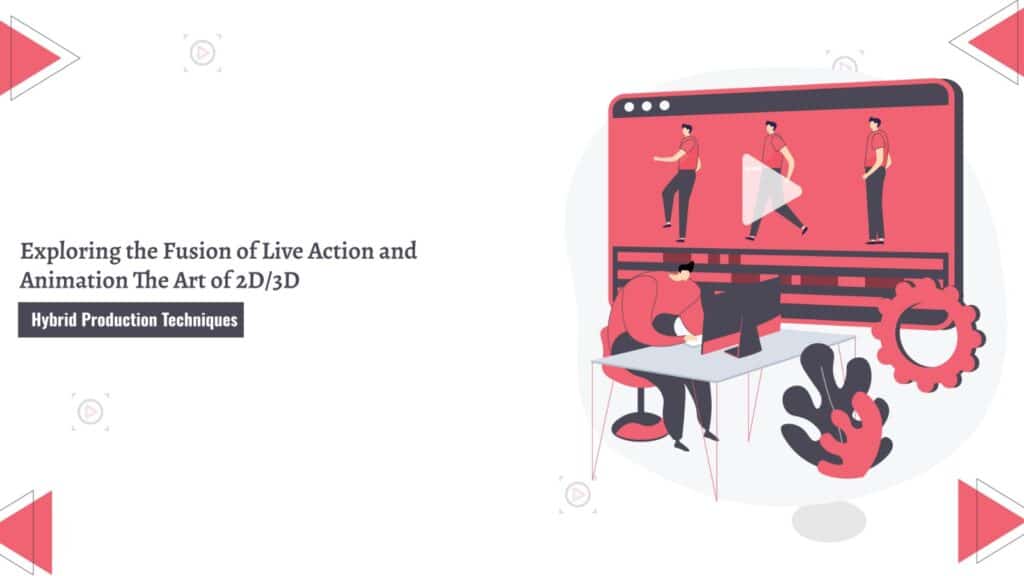
Animation and live action are two powerful storytelling tools—but when they collide, the result is something truly magical. In 2025, we’re seeing a creative renaissance where filmmakers, artists, and studios are experimenting boldly with live-action and animation hybrid techniques, merging human performance with stylized visuals in ways that redefine what’s possible on screen.
From cinematic blockbusters to indie shorts, the 2D and 3D animation fusion in filmmaking is pushing new creative boundaries, blending physical reality with illustrated imagination. And it’s not just about style—it’s about storytelling, audience engagement, and expanding the language of visual narratives.
In this guide, we’ll unpack how these hybrid productions work, what software is leading the charge, how to achieve seamless integration, and look at the most impressive real-world examples of live-action and animation integration.
Why Hybrid Productions Are Thriving in 2025
We live in a visually saturated world, where standing out means going beyond the expected. The fusion of animation and live action brings a unique aesthetic that captures attention, communicates emotion, and delivers experiences that feel both familiar and fantastical.
Hybrid production also allows:
- Creative freedom: Animate what can’t be filmed or imagined in traditional sets.
- Cost efficiency: Replace expensive sets or effects with artistic animation.
- Narrative depth: Use animation to represent dreams, memories, emotions, or abstract ideas.
- Enhanced visual identity: Establish a brand or directorial signature with a unique look.
From Hollywood to TikTok creators, live-action and animation hybrid techniques are becoming a go-to storytelling device in everything from film to music videos, advertising, and education.
Understanding Live-Action and Animation Hybrid Techniques
So what exactly are live-action and animation hybrid techniques?
At their core, these are workflows that combine filmed footage of real actors, environments, or objects with animated elements—whether hand-drawn 2D, stylized 3D, motion graphics, or visual effects.
Some popular hybrid approaches include:
✅ 2D Animation Overlay
Classic cartoons or vector animations composited over real footage (think Who Framed Roger Rabbit? or modern YouTube skits). These often use rotoscoping for realism.
✅ 3D Character Integration
CG characters placed into live-action scenes with lighting, shadows, and physics matching the real environment.
✅ Environment Enhancements
Animated skies, objects, or transitions that add motion and style without replacing the live footage entirely.
✅ Mixed Reality Storytelling
Interactive or immersive video where characters interact with AR-style animations or projections during performance.
These live-action and animation hybrid techniques vary widely in look and complexity—but they all serve the same purpose: to make storytelling more dynamic, engaging, and expressive.
The Rise of 2D and 3D Animation Fusion in Filmmaking
Beyond traditional hybrids, another evolution is taking place: 2D and 3D animation fusion in filmmaking.
This approach blends flat, hand-drawn or vector-style animation with full 3D elements—often combining the charm of 2D with the depth and realism of 3D. When incorporated into live-action footage, the result is a layered visual world that feels organic, stylized, and immersive.
Why Fuse 2D and 3D?
- Stylized storytelling: Maintain a handcrafted aesthetic while introducing dynamic movement or lighting.
- World-building: Create animated elements that “feel” flat in a 3D space—perfect for dream sequences, flashbacks, or fantasy.
- Performance capture: Use real actor motion to drive stylized characters or scenes.
Recent advances in real-time rendering engines, GPU power, and stylization tools are making this fusion more achievable than ever—making 2D and 3D animation fusion in filmmaking a hot trend in 2025.
Best Software for Hybrid Animation Production in 2025
If you’re looking to experiment or scale your own hybrid production, choosing the right tools is crucial. Here’s a breakdown of the best software for hybrid animation production this year:
🎥 Adobe After Effects
Still the go-to for compositing live-action and 2D animation. With plugins like Duik, Rubberhose, and Character Animator, you can create and animate characters over footage with relative ease.
🖥 Blender
Free, open-source, and immensely powerful for 3D animation and compositing. Blender allows for real-time rendering and stylization that makes it ideal for integrating animated 3D into video.
📦 Unreal Engine
A game engine turned filmmaking powerhouse. Unreal offers real-time 3D rendering and camera tracking, making it perfect for high-end hybrid productions with immersive environments.
✏️ Toon Boom Harmony
Great for hand-drawn or vector-style 2D animation. You can animate over video footage using frame-by-frame techniques or hybrid rigging workflows.
🧩 Nuke (by Foundry)
A professional-grade node-based compositor used in VFX-heavy productions. Ideal for advanced masking, tracking, and blending live-action with complex animation or simulations.
These best software for hybrid animation production give creators the tools to visualize, animate, and merge multiple visual worlds into one cohesive story.
How to Blend Live Action with Animation Seamlessly
You’ve probably seen hybrid animations that feel jarring or disconnected. So how do the pros achieve smooth, believable results? Here’s how to blend live action with animation seamlessly:
1. Match Lighting and Shadows
Lighting is one of the biggest giveaways. Your animated elements should mimic the direction, color, and intensity of your live-action lighting. Shadow integration is equally crucial for believability.
2. Use Realistic Camera Movement
Match the animation’s movement to your camera’s motion—especially if you’re using tracking shots or handheld footage. Tools like motion tracking in After Effects or Unreal’s camera rigs help here.
3. Pay Attention to Perspective
Animated objects must follow the same perspective rules as the real environment. Misalignment quickly breaks the illusion.
4. Use Color Grading to Match Visual Tone
Unify your footage and animation through consistent color correction or stylized grading. Even subtle tweaks can bring everything together.
5. Incorporate Interaction
Have actors physically interact with animated elements—look at them, touch them, or react to them. This anchors animation in reality.
Mastering how to blend live action with animation seamlessly takes time, but it’s worth it. The result is a rich visual layer that draws viewers into your story.
Top Examples of Live-Action and Animation Integration
Looking for inspiration? These are some of the top examples of live-action and animation integration that still influence artists and directors in 2025:
🎬 Who Framed Roger Rabbit? (1988)
A pioneer in hybrid storytelling. The film seamlessly integrates 2D characters into a live-action world, with believable eye-lines, shadows, and interactions.
🧙 Harry Potter and the Prisoner of Azkaban (2004)
The Marauder’s Map sequence blends live action and animated illustrations in a way that feels magical, immersive, and plot-integrated.
🌀 Scott Pilgrim vs. The World (2010)
Comic-style motion graphics, anime-inspired effects, and video game visuals layered over live action made this film a cult favorite for hybrid creativity.
💥 Spider-Man: Into the Spider-Verse (2018)
Though primarily animated, it inspired a wave of 2D and 3D animation fusion in filmmaking by blending hand-drawn styles with CG depth.
📱 Nike’s “You Can’t Stop Us” (2020)
Live footage was blended with animation, motion graphics, and seamless transitions to deliver a powerful, visually poetic ad campaign.
In 2025, newer examples continue to emerge—especially in music videos, branded content, and streaming animation hybrids.
Hybrid Storytelling in the Future
As technology continues to evolve, hybrid filmmaking will only grow in potential. The fusion of live action and animation is no longer a niche technique—it’s becoming a genre in its own right.
Expect more:
- AI-assisted animation that adapts to real-time footage
- Virtual production pipelines that simulate entire sets
- Augmented reality storytelling combining physical and digital in real time
- Interactive video where viewers engage with animated layers over real-world stories
The line between what’s real and what’s animated is disappearing. And with the right tools, techniques, and creative vision, you can be at the forefront of this movement.
Final Thoughts
The art of live-action and animation hybrid techniques in 2025 is about much more than cool effects. It’s a storytelling evolution—where emotion, technology, and artistry converge.
Whether you’re blending hand-drawn characters into filmed environments or merging 3D models with real-world sets, the fusion of media gives you a unique voice and visual language. By understanding the latest in 2D and 3D animation fusion in filmmaking, mastering how to blend live action with animation seamlessly, and exploring the best software for hybrid animation production, you’ll be ready to create content that doesn’t just look amazing—it resonates.
And as the industry continues to evolve, those who embrace the blend will stand out as the next generation of creative pioneers.
Frequently Asked Questions (FAQ’s)
How Can Hybrid Animation Enhance Storytelling?
Hybrid animation merges 2D and 3D animation techniques, enriching storytelling through several key enhancements:
- Visual Depth: By combining the spatial depth of 3D animation with the expressive qualities of 2D, hybrid animation creates a more immersive visual experience. This blend allows for nuanced storytelling where depth and dimension add layers of meaning and engagement.
- Artistic Expression: Hybrid animation leverages the unique strengths of both 2D and 3D styles. The integration of these techniques allows for innovative visual metaphors and enhanced emotional expression. Creators can craft visuals that are both artistically striking and deeply resonant.
- Dynamic Environments: This approach enables the creation of intricate and adaptable environments. The ability to blend detailed 3D backgrounds with 2D elements ensures that settings can evolve to meet narrative needs, making scenes more dynamic and impactful.
What Are Some Challenges Associated with Hybrid Animation?
While hybrid animation offers many advantages, it also presents several challenges:
- Technical Complexity: Combining 2D and 3D elements involves intricate technical processes. Managing layers, rendering, and compositing requires advanced skills and precise coordination to achieve a seamless integration.
- Consistency: Maintaining a consistent visual style between 2D and 3D elements can be challenging. Ensuring that both components align harmoniously demands careful attention to detail and alignment to avoid visual dissonance.
- Resource Intensity: Despite its potential to streamline production, hybrid animation can still be resource-intensive. It often requires substantial expertise and high-end software, which can impact both time and budget.
Can Hybrid Animation Be Used for Different Types of Projects?
Yes, hybrid animation is highly versatile and suitable for a range of projects, including:
- Feature Films: To create visually stunning and engaging animated movies that captivate audiences with a blend of artistic styles.
- TV Shows: For crafting unique and dynamic episodic content that stands out with its innovative visual approach.
- Advertising: To combine traditional and modern styles, creating impactful and memorable commercials.
- Video Games: To enhance storytelling through a mix of artistic styles, adding depth and intrigue to gameplay experiences.
- Educational Content: To produce engaging and informative animations that leverage both 2D and 3D elements for enhanced learning experiences.
How Does Hybrid Animation Differ from Traditional 2D and 3D Animation?
- 2D Animation: This technique involves creating flat, two-dimensional images through traditional hand-drawn methods or software. It is known for its simplicity, speed, and artistic flexibility, making it ideal for stylized and abstract visuals.
- 3D Animation: Involves designing three-dimensional objects and environments using advanced software. It offers enhanced realism, versatility, and higher production value, suited for immersive and detailed visual experiences.
- Hybrid Animation: Combines the artistic charm of 2D with the depth and realism of 3D. This integration creates a unique visual style that leverages the strengths of both approaches, resulting in richer and more dynamic animations.
What Is the Future of Hybrid Animation?
The future of hybrid animation appears promising, with ongoing advancements in VR and AR technologies adding new layers of interactivity and realism. As artists and creators continue to explore this innovative approach, we can anticipate even more dynamic and engaging visual experiences. The evolution of hybrid animation will likely push the boundaries of traditional and modern techniques, leading to groundbreaking developments in animated storytelling.





